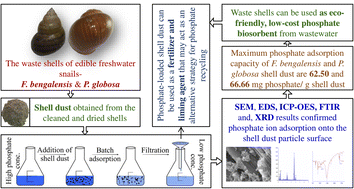Phosphate ion removal from aqueous solution using snail shell dust: biosorption potential of waste shells of edible snails
Abstract
The freshwater snails, Filopaludina bengalensis and Pila globosa are widely used for human consumption and as a feed in aquaculture in India and Bangladesh. The generation of shells as a waste product following meat extraction from the live snails incites their utilisation as a potential biomaterial. Shell dust was prepared from the dried shells of F. bengalensis (FSD) and P. globosa (PSD) and employed for phosphate adsorption from aqueous solutions. Batch adsorption experiments were performed to examine the effects of various experimental conditions, such as biosorbent dose, agitation speed, temperature, contact time, pH, initial concentration of phosphate ions, and presence of co-existing ions. SEM, EDS, ICP-OES, FTIR, and XRD results indicated that phosphate ions were adsorbed onto the surface of shell dust particles. The experimental data fitted with the Langmuir isotherm with a maximum adsorption capacity of 62.50 and 66.66 mg g−1 for FSD and PSD. The pseudo-second order kinetic model was well fitted, indicating the chemical adsorption process, and the thermodynamic parameters indicated that the adsorption mechanism of phosphate was spontaneous, feasible, and endothermic. Therefore, the results have established the potentiality of the waste shells of edible snails to be used as an eco-friendly and low-cost biosorbent for phosphate removal from wastewater.



 Please wait while we load your content...
Please wait while we load your content...